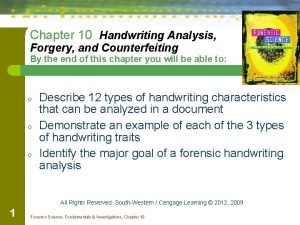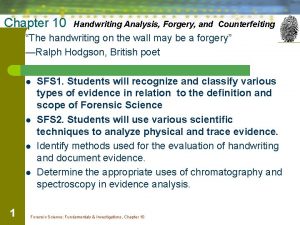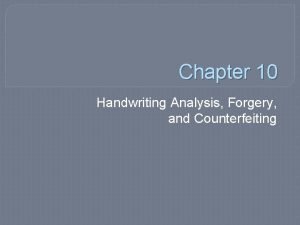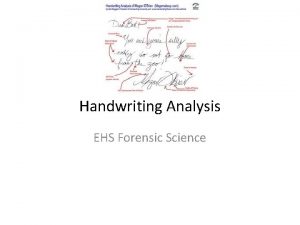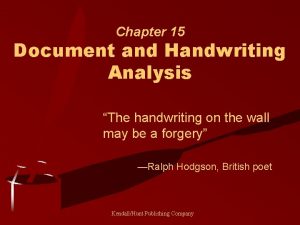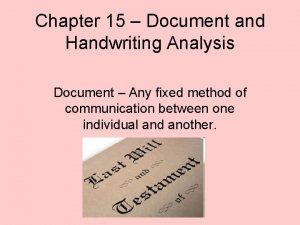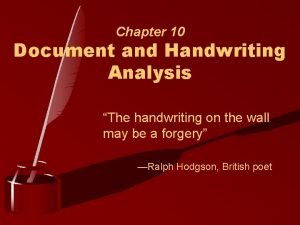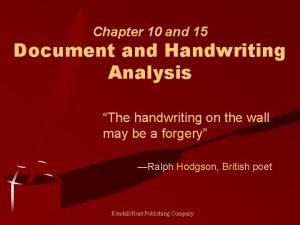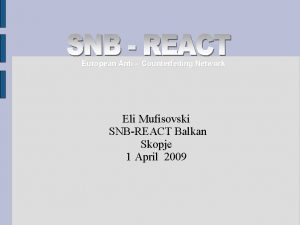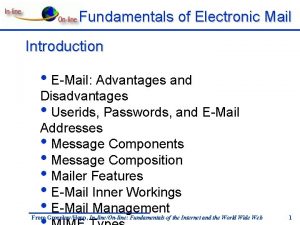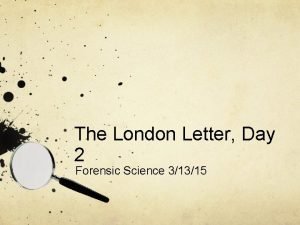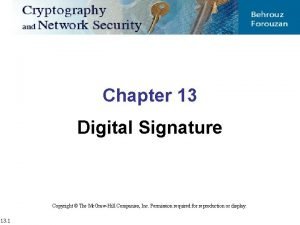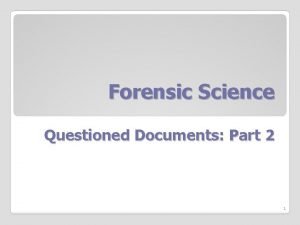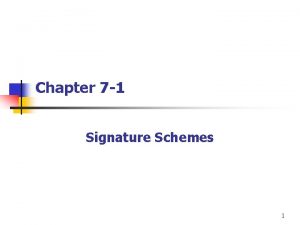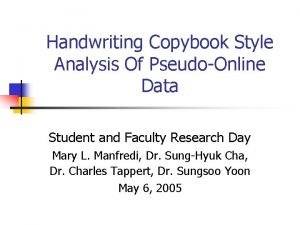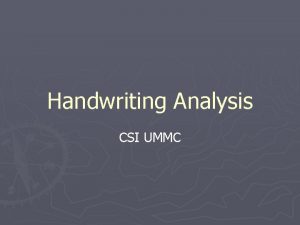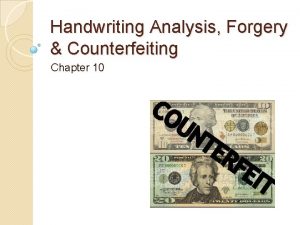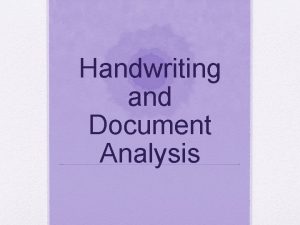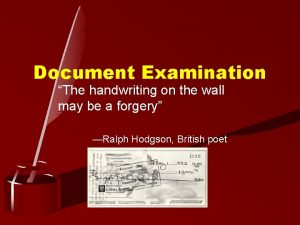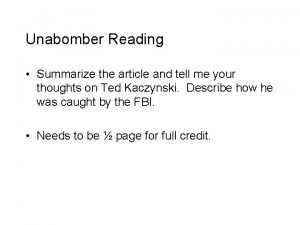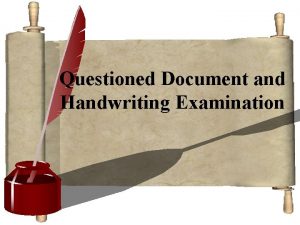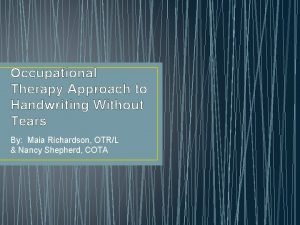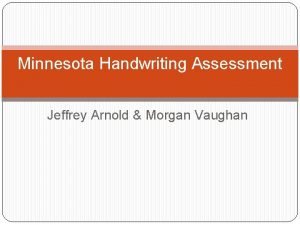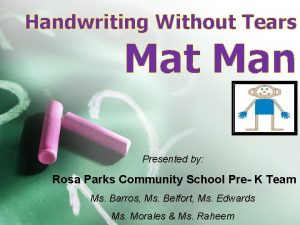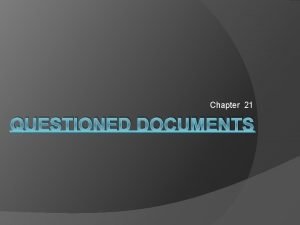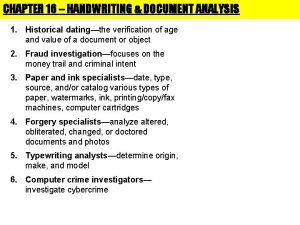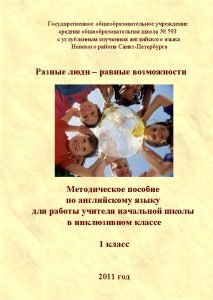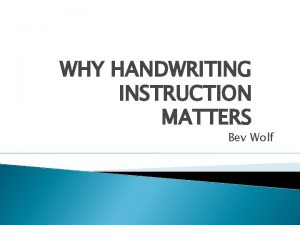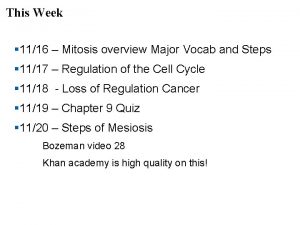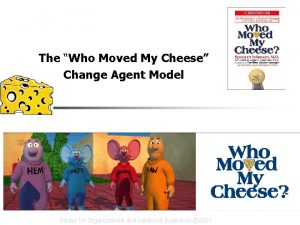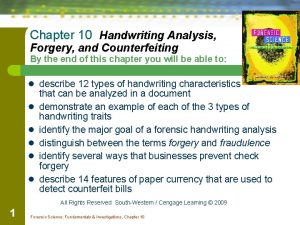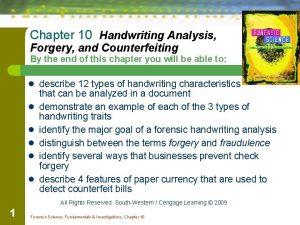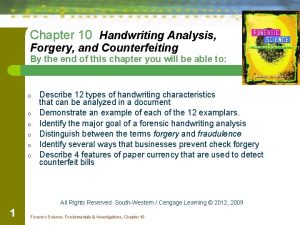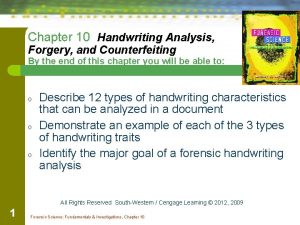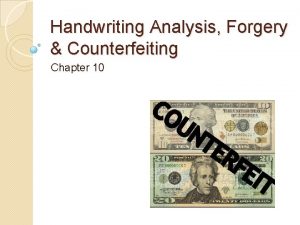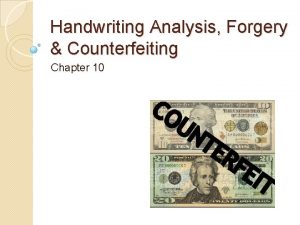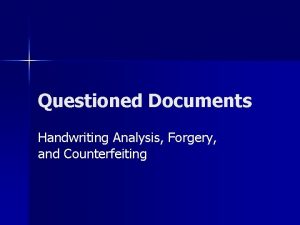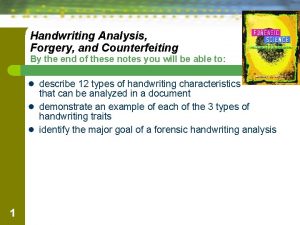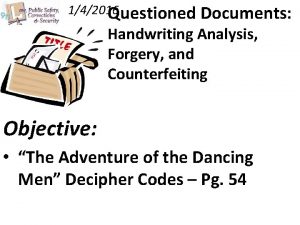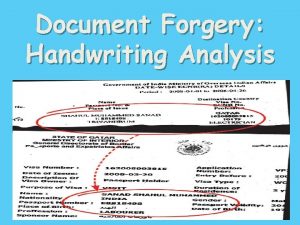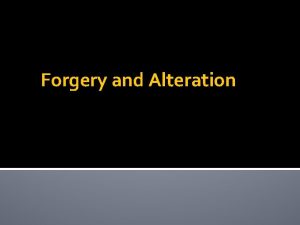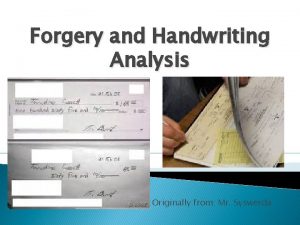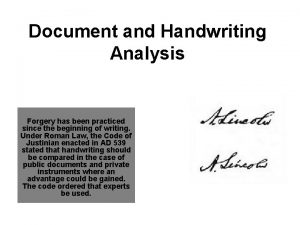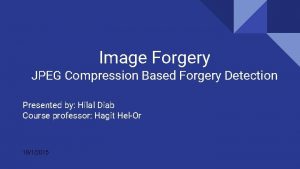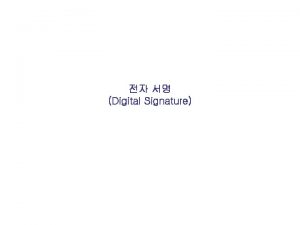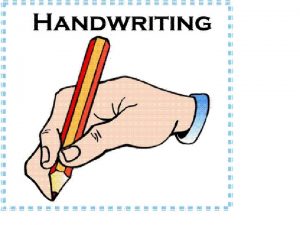Chapter 10 Handwriting Analysis Forgery and Counterfeiting The






































- Slides: 38

Chapter 10 Handwriting Analysis, Forgery, and Counterfeiting “The handwriting on the wall may be a forgery” —Ralph Hodgson, British poet l l 1 SFS 1. Students will recognize and classify various types of evidence in relation to the definition and scope of Forensic Science SFS 2. Students will use various scientific techniques to analyze physical and trace evidence. Identify methods used for the evaluation of handwriting and document evidence. Determine the appropriate uses of chromatography and spectroscopy in evidence analysis. Forensic Science: Fundamentals & Investigations, Chapter 10

Introduction l Document analysts examine and compare questioned documents with known material. l Experts in the field investigate such things as handwriting, computer printouts, commercial printing, paper, and ink. l They may study threatening, ransom, or suicide notes. 2 Forensic Science: Fundamentals & Investigations, Chapter 10

History of Forensic Handwriting Analysis l In the 1930 s, handwriting analysis played a role in the famous Lindbergh case. l In 1999, the United States Court of Appeals determined that handwriting analysis qualified as a form of expert testimony. l To be admissible in court, however, scientifically accepted guidelines must be followed. 3 Forensic Science: Fundamentals & Investigations, Chapter 10

12 Handwriting Characteristics l l l 4 Line Quality Word and Letter Spacing l l l Ratio of the height, width l and size of letters. Pen Lifts Connecting strokes Beginning and ending strokes Forensic Science: Fundamentals & Investigations, Chapter 10 l l Unusual Letter Formation Shading or pen pressure Slant Baseline Habits Flourishes or embellishments Diacritic Placement (i’s and t’s)

Copy the following on lined paper l 5 The quick brown fox jumped over the lazy dog. I am a student in Coach Bisesi’s 4 N 6 class learning about different techniques scientists use to solve crimes. Today, I will learn about handwriting analysis and forgery. The quick brown fox jumped over the lazy dog and counted 1, 2, 3, 4, 5, 6, 7, 8, 9, 10.

Line quality Are the lines smooth or shaky? Original Forgery

Spacing - words and letters What is the spacing between letters and words? Is the spacing size consistent?

Ratio - height, width, size Are the letters consistent in shape & size? Original Forgery

Pen lifts and separation Does the person stop to form new letters and begin words? Are the pen lifts consistent? Forgeries may have lifts in unusual places. Original Forgery

Connecting strokes Compare how letters are linked. Are capitals connected to lowercase letters and are there connecting strokes between letters and words? Original Forgery

Beginning and ending strokes Are these straight, curled, long or short, an upstroke or a downstroke? Original Forgery

Unusual letter formation Are there any unusually formed letters such as backward, letters with a tail, or unusual capitals? Original Forgery

Shading or pen pressure Differences in shading = differences in pen pressure Is the pen pressure on the upward or the downward strokes? Original Forgery

Slant Is slant left or right or straight up and down? Is there consistency between the slant of letters. Original Forgery

Baseline habits Original Is the writing above, below, or right on a line? Forgery

Flourishes and embellishments Are their any? If so what are they? Original Forgery

Diacritic placement - dot i, cross t Is the line on the “t” in proportion? Are the “i’s” dotted left or right? Original The i dot and t cross tend to the right of the letter. Forgery The i dot is varied. The t cross is even. The form of the letter t is wider at the base.

Handwriting Samples § § § 18 The subject should not be shown the questioned document The subject is not told how to spell words or use punctuation The subject should use materials similar to those of the document The dictated text should match some parts of the document The subject should be asked to sign the text Always have a witness Forensic Science: Fundamentals & Investigations, Chapter 10

Handwriting Identification § § 19 Analysis of the “knowns” with a determination of the characteristics found in the known Analysis of the questioned writing and determination of its characteristics Compare the questioned writing with the known writing. The document examiner must have enough exemplars to make a determination of whether or not the two samples match. Forensic Science: Fundamentals & Investigations, Chapter 10

Technology Used in Handwriting Analysis Biometric Signature Pads l l This computerized pad “learns” to recognize how a person signs his or her name based on the speed, pressure, and rhythm of the signing. Forgeries then are recognized by the detection of even slight differences. Computerized Analysis of Handwriting l l 20 Computers can make objective comparisons between handwritings. Suspect signatures can be compared with ones stored in databases. Forensic Science: Fundamentals & Investigations, Chapter 10

Handwriting Evidence in the Courtroom l The expert shows how comparisons were made. l The defense attorney likely will cross-examine the handwriting expert. Shortcomings in Analysis l A particular piece of handwriting can be different from its usual style because of factors such as fatigue. l Experts can miss details. 21 Forensic Science: Fundamentals & Investigations, Chapter 10

FISH l 22 The Secret Service maintains a handwriting computer data base called the Forensic Information System for Handwriting (FISH). It stores writing samples to use to compare to threat letters received by the USA. Forensic Science: Fundamentals & Investigations, Chapter 10

Forgery Forged documents can include such things as checks, employment records, legal agreements, licenses, and wills. l Fraudulence is forgery done for material gain. l Check forgery can include: – ordering another’s checks from a deposit slip. – altering a check. – intercepting another’s check, altering, and cashing it. – creating a check from scratch. l 23 Forensic Science: Fundamentals & Investigations, Chapter 10

Prevention of Check Fraud l l l Print checks on chemically sensitive paper Use large font requiring more ink to make alterations more difficult Use high resolution borders on checks Print checks with multiple color patterns Embed fibers that glow under light sources Use chemical wash detection systems that change color when check is altered

Literary Forgery l Letters or other documents written by famous people can be very valuable. l The best literary forgers aim to duplicate the original document by using materials similar to those used for the original: – old paper – chemically treated materials to fake an older look – inks mixed from substances that would have been used at the time – watermarks that add the appearance of age – tools and styles that would have been popular at the time 25 Forensic Science: Fundamentals & Investigations, Chapter 10

Forensic Linguist 26 § Experts that look at the linguistic content (the way something is written) of a questioned document. § Language that is used can help to establish the writer’s age, gender, ethnicity, level of education, professional training, and ideology. Forensic Science: Fundamentals & Investigations, Chapter 10

Ink Chromatography is a method of physically separating the components of inks Types 27 § HPLC—high-performance liquid chromatography § TLC—thin-layer chromatography § Paper Chromatography Forensic Science: Fundamentals & Investigations, Chapter 10

Paper Chromatography of Ink Two samples of black ink from two different manufacturers have been characterized using paper chromatography. 28 Forensic Science: Fundamentals & Investigations, Chapter 10

Retention Factor (Rf) § § 29 Forensic Science: Fundamentals & Investigations, Chapter 10 A number that represents how far a compound travels in a particular solvent It is determined by measuring the distance the compound traveled and dividing it by the distance the solvent traveled.

International Ink Library The U. S. Secret Service maintains an ink database that includes over 12, 000 inks. Every year ink and pen manufacturers are asked to submit ink formulas to the library. 30 Forensic Science: Fundamentals & Investigations, Chapter 10

Evidence 31 § Class characteristics may include general types of pens, pencils or paper. § Individual characteristics may include unique, individual handwriting characteristics, trash marks from copiers or printers Forensic Science: Fundamentals & Investigations, Chapter 10

Paper Differences § § § § 32 § Raw material Weight Density Thickness Color Watermarks Age Fluorescence Forensic Science: Fundamentals & Investigations, Chapter 10

Pencils Hardness Scale—a traditional measure of the hardness of the "leads” in pencils. § The hardness scale, from softer to harder, takes the form. . . , 3 B, 2 B, B, HB, F, H, 2 H, 3 H, 4 H, . . . , with the standard "number 2" pencil being of hardness 2 H. 33 Forensic Science: Fundamentals & Investigations, Chapter 10

Document Alterations § Obliterations - removal of writing by physical or chemical means can be detected by: § § Indentations can be detected by: § § 34 Microscopic examination UV or infrared (IR) light Digital image processing Oblique lighting Electrostatic detection apparatus (ESDA) Forensic Science: Fundamentals & Investigations, Chapter 10

Art Forgeries 35 Forensic Science: Fundamentals & Investigations, Chapter 10

Counterfeiting money is a crime stretching back into ancient times. Items most often forged today include: – – – 36 currency traveler’s checks food stamps certain bonds postage stamps Forensic Science: Fundamentals & Investigations, Chapter 10

Counterfeiting In 1996 the government starting adding new security features to our paper money due to the advanced copying technologies that have raised the incidences of counterfeiting. 37 Forensic Science: Fundamentals & Investigations, Chapter 10

Counterfeit Currency l The Secret Service has worked with electronics and software makers to add security features to paper currency that makes forgery extremely difficult. Scanning cannot reproduce these security features. l The first security feature is the feel of the paper. Regular printer paper contains starch. Paper bills contain rag fiber instead of starch. 38 Forensic Science: Fundamentals & Investigations, Chapter 10
 Literary forgery forensics
Literary forgery forensics Dot diacritic
Dot diacritic 12 handwriting characteristics
12 handwriting characteristics Forensic handwriting analysis video
Forensic handwriting analysis video Handwriting analysis forgery and counterfeiting
Handwriting analysis forgery and counterfeiting A person who scientifically analyzes handwriting
A person who scientifically analyzes handwriting Chapter 15 document and handwriting analysis
Chapter 15 document and handwriting analysis Charred document example
Charred document example Mormon and freemason forgeries
Mormon and freemason forgeries Chapter 15 document and handwriting analysis
Chapter 15 document and handwriting analysis Eli mufisovski
Eli mufisovski Anti counterfeiting trade agreement
Anti counterfeiting trade agreement Anti counterfeiting trade agreement
Anti counterfeiting trade agreement Pengertian email forwarding
Pengertian email forwarding Simulated forgery definition
Simulated forgery definition Digital signature forgery
Digital signature forgery Simulated forgery definition
Simulated forgery definition Existential forgery
Existential forgery Copybook style
Copybook style Graphology
Graphology Csi handwriting analysis
Csi handwriting analysis 12 exemplars of handwriting
12 exemplars of handwriting 12 handwriting characteristics
12 handwriting characteristics Document expert definition
Document expert definition What are the phases of handwriting examination
What are the phases of handwriting examination Dot diacritic
Dot diacritic Flourishes and embellishments in handwriting
Flourishes and embellishments in handwriting Questioned documents include
Questioned documents include Diver letters handwriting without tears
Diver letters handwriting without tears Minnesota handwriting assessment
Minnesota handwriting assessment Mat man song
Mat man song 12 handwriting characteristics
12 handwriting characteristics Graphometrist
Graphometrist The 12 characteristics of handwriting
The 12 characteristics of handwriting Handwriting characteristics
Handwriting characteristics Handwriting objectives
Handwriting objectives Wolves in cursive
Wolves in cursive Handwriting คือ
Handwriting คือ Who moved my cheese change management
Who moved my cheese change management
